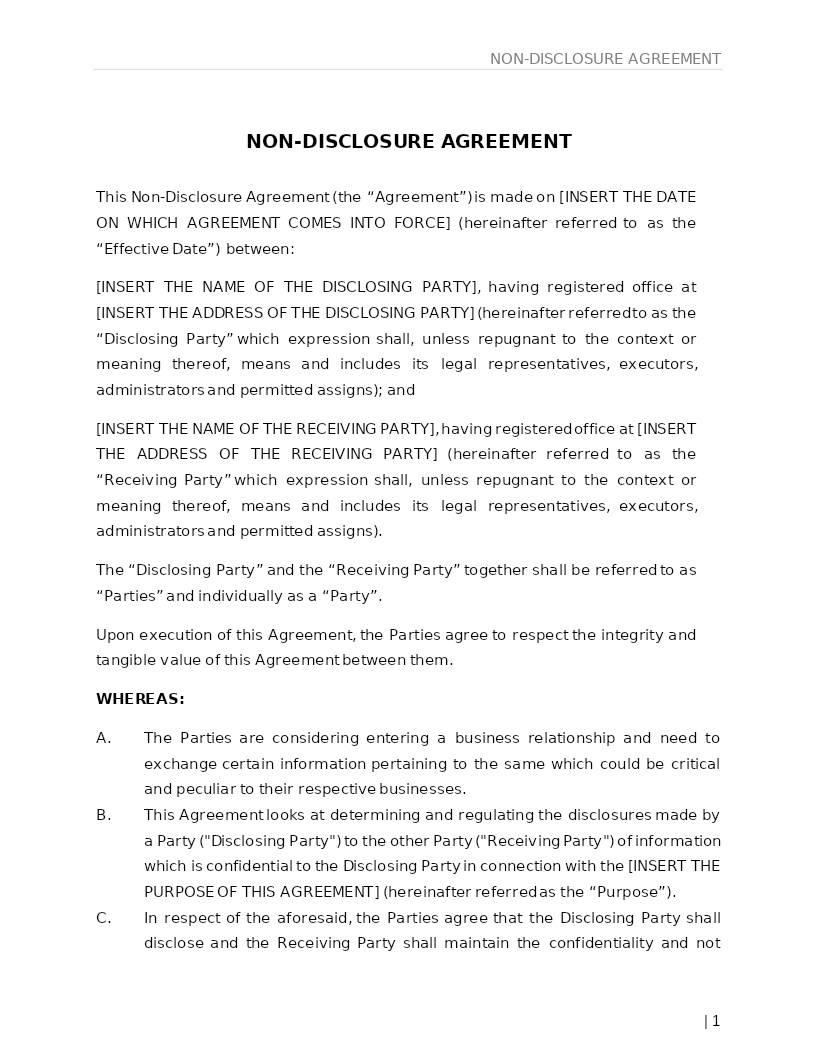
NON-DISCLOSURE AGREEMENT
How does it work?
1. Choose this template
Start by clicking on "Fill out the template"
2. Complete the document
Answer a few questions and your document is created automatically.
3. Save - Print
Your document is ready! You will receive it in Word and PDF formats. You will be able to modify it.
What Is a Non-Disclosure Agreement (NDA)?
A Non-Disclosure Agreement (NDA), also known as a Confidentiality Agreement, is a legally binding contract between two or more parties that defines how confidential information will be shared, protected, and used. It ensures that sensitive business, technical, or personal information disclosed during a professional or commercial relationship remains private and is not misused or shared without authorization.
NDAs are widely used in business relationships such as partnership discussions, mergers and acquisitions, investment negotiations, product development, client engagements, and employment arrangements.
A well-drafted NDA protects trade secrets, intellectual property, business strategies, financial data, and proprietary information thereby fostering trust, transparency, and responsible data sharing between parties.
This template is:
• Lawyer-drafted and legally neutral and suitable for use across multiple jurisdictions.
• Applicable to individuals, companies, startups, and consultants.
• Covers mutual and one-way confidentiality, duration, permitted disclosures, and remedies for breach.
• Customizable for business, employment, technology, or creative collaborations.
Key Features of a Non-Disclosure Agreement
1. Definition of Confidential Information
Specifies what constitutes “confidential information,” including documents, business plans, client data, product designs, software code, or trade secrets shared between the parties.
2. Purpose of Disclosure
States the legitimate reason for sharing confidential information, such as evaluation of a potential partnership, business deal, or project.
3. Obligations of the Receiving Party
Requires the receiving party to maintain confidentiality, limit access to authorized personnel, and use the information only for the stated purpose.
4. Permitted Disclosures
Allows disclosure in limited circumstances for example, to employees or advisors bound by similar confidentiality obligations, or when required by law or court order.
5. Exclusions from Confidentiality
Clarifies that the obligation does not apply to information that is:
• already in the public domain,
• independently developed without reference to disclosed information, or
• lawfully obtained from another source without confidentiality restrictions.
6. Term & Duration
Specifies how long confidentiality obligations remain in force typically from 2 to 5 years, or indefinitely for trade secrets.
7. Ownership of Information
States that all disclosed information remains the property of the disclosing party, and no license or ownership rights are granted unless expressly stated.
8. Return or Destruction of Materials
Requires the receiving party to return or destroy confidential materials upon request or upon termination of the agreement.
9. Remedies for Breach
Provides for injunctive relief, damages, or other equitable remedies if confidential information is disclosed or misused.
10. Governing Law & Dispute Resolution
Specifies the governing law and jurisdiction (or arbitration) agreed upon by the parties. This section is adaptable to any jurisdiction based on mutual consent.
Types of Non-Disclosure Agreements
One-Way (Unilateral) NDA: Only one party discloses confidential information (e.g., employer–employee).
Mutual (Bilateral) NDA: Both parties share confidential information (e.g., joint ventures, partnerships).
Multilateral NDA: More than two parties are involved in a project requiring shared confidentiality.
Why You Need a Non-Disclosure Agreement
- Prevents unauthorised disclosure of trade secrets and sensitive business data.
- Creates legal accountability for both parties.
- Facilitates safe collaboration between businesses, investors, and partners.
- Builds professional trust through clear confidentiality boundaries.
- Protects intellectual property and proprietary knowledge.
FAQs on Non-Disclosure Agreements
Q1: Is an NDA legally binding?
Yes. Once signed by authorized representatives, it becomes a legally enforceable contract, provided it meets general contract law principles such as offer, acceptance, and consideration.
Q2: Can an NDA be mutual or one-sided?
Yes. NDAs can be structured as mutual (both parties disclose information) or unilateral (only one party shares information).
Q3: Can NDAs be signed electronically?
Yes. NDAs can be executed electronically, and e-signatures are legally valid in most jurisdictions ( e.g. India, UK, US, France, Singapore, etc ) under global e-signature laws such as the UNCITRAL Model Law on Electronic Commerce and LCIA.
Q4: What happens if a party breaches an NDA?
The non-breaching party can seek injunctions, damages, or specific performance through legal action or arbitration, depending on the agreement.
Q5: Does an NDA protect intellectual property?
While NDAs do not grant IP rights, they protect the confidentiality of proprietary ideas, inventions, and information until formal IP registration or protection is obtained.
Related Templates You May Need
• Consulting Services Agreement